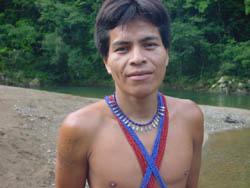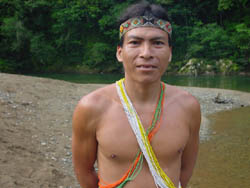|
History of Our Tourism
We started working in tourism in 1996. At first,
we sought and received a lot of assistance from the Panama Tourism
Bureau (IPAT), the World Bank, and several local Non-Governmental
Organizations (NGO's). They helped us get organized and build
relationships with local tour operators. We received training in
customer service and visitor safety.
As we started out, we used an informal approach to
our project, organizing a community committee for tourism.
With much work and assistance, this evolved into our very own
community-based NGO called Wanamera Emberama Chagres.
That means “Let's go to the Embera of the
Chagres.” Chagres is
the name of the river valley where we live. Almost all of the
adult residents of our village are members of our NGO.
We elected a board of directors, all from the village, and the
board worked with local tour operators to bring visitors to our village.
Last year we restructured a bit and decided to
separate the tourism activities from those of the NGO.
We gave our tourism project a new name, "Tranchichi
Embera Chagres." Tranchichi
is our name for leaf-cutter ants. If
you've ever seen these ants marching along the forest floor carrying
giant chunks of leaves to their nest, you would know that they are very
hardworking and organized. Like us.
In addition to working hard to learn about what
our visitors enjoy, we are also working very hard to learn about
accounting, marketing and computers so we can run our project more
efficiently and independently.
AMPYME, the Panama Authority for Micro-, Small-
and Medium-Size Businesses, is giving us training in these areas and
helping us to legally register our tourism project as a community-based
micro-business. This means a lot of hard work, but we will be proud to have
our own registered business.

Choosing tourism
For us, tourism is a means to earn the cash our
families need to buy things like cooking oil, clothing, gasoline and
healthcare and to pay expenses for sending our kids outside the village
for secondary-school education. Each child or adult who participates in
our community tourism earns a wage.
Their pay varies between $1 and $9 for each event, depending on
the task they perform (such as cook, dancer, boatman, guide).
If the visiting group is small, say less that four
people, we can't pay everyone their full wage, but we still split up the
profit after the basic costs are paid.
When there is a profit after paying wages, we put it in a fund to
use for outboard-motor fuel, maintenance and other community needs.

What we offer
What we offer is usually referred to as cultural
eco-tourism. The cultural
part means that visitors learn about and interact with us; the
ecological part means they learn about the rainforest; and, all of it
goes on in way that is low-impact to our natural environment and our way
of life. Visitors come here
to experience nature, but they don't take the plants and animals with
them when they leave. Instead,
they take the memory of their unique experience, a lot of photographs
and their trash!

Language
We enjoy sharing our culture with people who visit
us. We also like learning about the places and cultures that our
visitors come from. We speak Spanish and our own native language, Emberá,
but some of us are trying to learn some basic English.
We use the tour-operator guides to translate from Spanish into
the visitor’s language.

Visiting for the day
A one-day visit consists of us meeting you at
"the port," a river landing under a giant Corotú tree
on Lake Alajuela (also called Madden Lake) and taking you about an hour
upriver in a dugout canoe we call a “piragua.”
When the river is low, the trip is slightly longer and a bit more
adventurous than when it is higher.
“Adventurous” means you get to watch us pole
through some mild but shallow rapids, and maybe, depending on the
current, you get to see us push the canoe through the shallow rapids on
foot! Don't worry, you don't have to get wet!
Along the riverbank, you may see crocodiles,
caiman, or river otter, and you will definitely see birds such as
parrots, parakeets, toucans and kingfishers, to name a few.
As the river doubles back around the last bend before you sight
the village, you will hear us playing our traditional music on deerskin
drums, maracas and bamboo flutes to welcome you.
Our hilltop village comes into view, and the sandy riverbank
below it, where we are waiting in our full ceremonial clothing to greet
you.
You will immediately be invited to get out of the
hot tropical sun and relax in our thatched-roof community house. Many of
us will already be there, talking among ourselves, cooking the lunch we
plan to serve or working on traditional handcrafts.
While you cool off, we tell you about our
community, culture, history, traditional artwork and way of life.
You can ask questions, and we might ask you a few as well!.
While the cooks prepare lunch, we like to take you for a one-hour
hike on a rainforest trail where we identify and describe the uses of
medicinal and culturally significant plants.
It is a beautiful walk and not too strenuous, but
for those who would prefer to stay behind, you can see many of the same
plants growing right in the community.
You can also sit in the shade and watch the iguanas that our
elementary-school kids are raising.
The children can tell you everything you ever wanted to know
about protecting wild iguanas, raising them in captivity and cooking the
domesticated ones up for dinner!
After lunch, you can swim in the river,
wander through the village or just relax and talk.
Soon we call everyone together for a traditional dance
exhibition. After
performing a few numbers and you have seen how we dance, we invite you
to join us. Our men will
invite lady visitors to dance but our women are a bit shy, so male
visitors, please take the initiative and ask them.
Throughout your visit, we have our
traditional artwork on display. Feel
free to touch, photograph, ask about and purchase anything that might
catch your eye.

Staying overnight
Visitors
who stay overnight have more time to enjoy the rainforest surrounding
us. You can experience everything that is offered during the day
trip, but you can also arrange to visit a waterfall in the jungle, go
fishing or bird watching or hear a storyteller perform at night.
We have a built a traditional house, we like to
call it the “hotel,” right into the side of the hill with the best
view of the river. You can rest there in a hammock and let the sound of
the rapids lull you to sleep. These
are also our accommodations for overnight visitors.

Looking for something special
If
you are looking for a specific experience and want to stay for one or
several nights, just ask. We
take requests from birdwatchers, survival trekkers, kayakers, nature
photographers and people who want to fish or simply take more time to
absorb our peaceful, natural environment.
Those looking for a challenging trekking experience may find
themselves running to catch up with our swift guides!
By all means, let us know and we will see what we can do to
accommodate you.

Who visits and how
International
We get visitors from all over the world. They
usually contact tour operators in Panama City.
It is good to use a tour operator if you have special needs, are
from another country and don't speak Spanish or don't have local
transportation.
We recommend Terra
Tours.
We like to work with Ingrid and Itzel
at Terra Tours because they also run an NGO which has supported us in our struggles to
organize and run our tourism project.
We have worked out a deal with them to receive a higher
percentage when a visitor contacts them and mentions our web page.
So don’t forget to mention it!!
Within Panama
We
get some tourism from Panamanians and other Spanish speakers who are
either working in or visiting Panama for an extended period of time.
Quite a few Panamanian student groups have visited and even spent
the night.
Our local visitors come to us in two ways:
through tour operators or by contacting us directly.
The latter arrange their own transportation to Lake Alajuela in
the Chagres National Park.
When groups contact us directly, we earn a higher
rate per visitor than when they come to us through an agency, and it is
less expensive for the visitors as well.
But if you don't have a Spanish-speaker among you or don't have
transportation to the port, then you might want to consider the use of a
tour operator.

Driving directions from Panama City
Take the Transisthmian Highway to the community of
Cabima.
One way to get on the Transisthmian Highway is to
can take the Corredor Norte tollway to the Tinajitas exit and turn north
on the Trans-isthmian Highway near Torrijos Carter.
Continue north toward Colon for 6.8 kilometers to
Cabima, where you will see a Pío-Pío restaurant in a small shopping
center on the right.
Turn right after the shopping center and follow
the road as it curves to the left and continues for 6.5 kilometers until
you reach the Bayano Cement Factory (Cemento Bayano).
Turn left at the factory’s sign marked "Ventas."
Here the pavement stops and the road turns to dirt.
Continue on for 8 kilometers until you reach a
green and yellow one-story building on your left.
This is the Panama National Environmental Agency (ANAM)
station in Chagres National Park.
Pull in and register as a park visitor and pay a
small entrance fee ($1 per person for Panamanians, $3 for others).
Exiting the station, turn left onto the dirt road
and take the first right you come to.
Follow this road to the lake. This is the port of Corotú.
Welcome!

What to bring
When you visit us, here are some suggestions on
what to bring:
- bottled water
- sunscreen
- hat
- bug repellant
- shorts
- waterproof sandals
- binoculars
- camera/film/batteries
- rain poncho (April through December)
- garbage bag for packing out
Overnighters should also consider bringing:
- a lightweight sleeping bag
- long pants
- long-sleeve shirt
- socks and tennis shoes
- mosquito net
- flashlight

Things you should know
- We discourage drinking alcohol in the community
without the consent of the Noko, our traditional leader.
- The village water supply flows through a PVC
tube from a clean creek high above the village.
However, we do not chlorinate it.
- We do not have flushing toilets, but instead
rely on latrines.
- We bath in the river and you may do so, too. We
do have very basic shower facilities for visitors.
- Please bring cash in small denominations ($1
and $5) as we have difficulty making change for larger bills. ,
- We
expect you to take photographs, so don't be shy!
|













